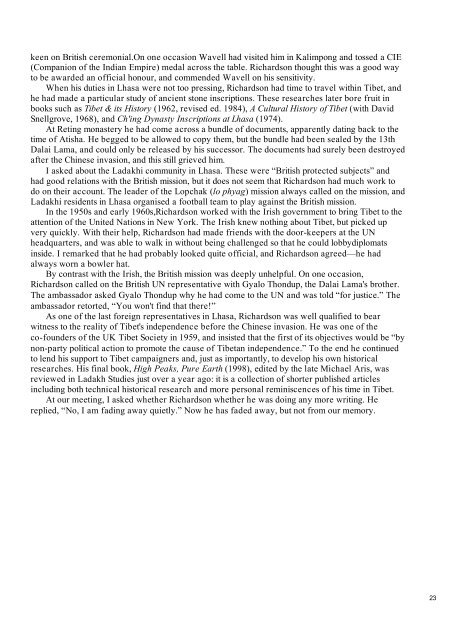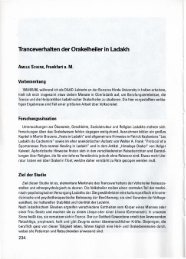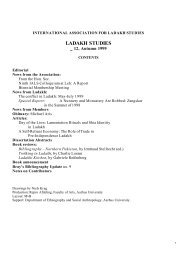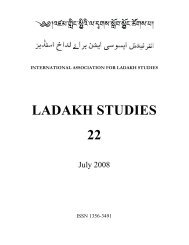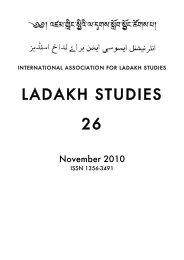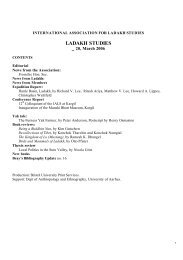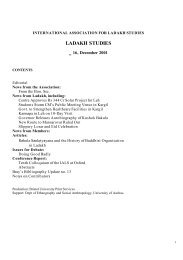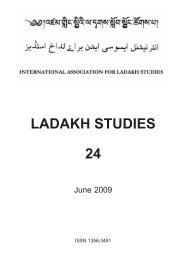LADAKH STUDIES 14, Autumn 2000 - International Association for ...
LADAKH STUDIES 14, Autumn 2000 - International Association for ...
LADAKH STUDIES 14, Autumn 2000 - International Association for ...
You also want an ePaper? Increase the reach of your titles
YUMPU automatically turns print PDFs into web optimized ePapers that Google loves.
keen on British ceremonial.On one occasion Wavell had visited him in Kalimpong and tossed a CIE<br />
(Companion of the Indian Empire) medal across the table. Richardson thought this was a good way<br />
to be awarded an official honour, and commended Wavell on his sensitivity.<br />
When his duties in Lhasa were not too pressing, Richardson had time to travel within Tibet, and<br />
he had made a particular study of ancient stone inscriptions. These researches later bore fruit in<br />
books such as Tibet & its History (1962, revised ed. 1984), A Cultural History of Tibet (with David<br />
Snellgrove, 1968), and Ch'ing Dynasty Inscriptions at Lhasa (1974).<br />
At Reting monastery he had come across a bundle of documents, apparently dating back to the<br />
time of Atisha. He begged to be allowed to copy them, but the bundle had been sealed by the 13th<br />
Dalai Lama, and could only be released by his successor. The documents had surely been destroyed<br />
after the Chinese invasion, and this still grieved him.<br />
I asked about the Ladakhi community in Lhasa. These were “British protected subjects” and<br />
had good relations with the British mission, but it does not seem that Richardson had much work to<br />
do on their account. The leader of the Lopchak (lo phyag) mission always called on the mission, and<br />
Ladakhi residents in Lhasa organised a football team to play against the British mission.<br />
In the 1950s and early 1960s,Richardson worked with the Irish government to bring Tibet to the<br />
attention of the United Nations in New York. The Irish knew nothing about Tibet, but picked up<br />
very quickly. With their help, Richardson had made friends with the door-keepers at the UN<br />
headquarters, and was able to walk in without being challenged so that he could lobbydiplomats<br />
inside. I remarked that he had probably looked quite official, and Richardson agreed—he had<br />
always worn a bowler hat.<br />
By contrast with the Irish, the British mission was deeply unhelpful. On one occasion,<br />
Richardson called on the British UN representative with Gyalo Thondup, the Dalai Lama's brother.<br />
The ambassador asked Gyalo Thondup why he had come to the UN and was told “<strong>for</strong> justice.” The<br />
ambassador retorted, “You won't find that there!”<br />
As one of the last <strong>for</strong>eign representatives in Lhasa, Richardson was well qualified to bear<br />
witness to the reality of Tibet's independence be<strong>for</strong>e the Chinese invasion. He was one of the<br />
co-founders of the UK Tibet Society in 1959, and insisted that the first of its objectives would be “by<br />
non-party political action to promote the cause of Tibetan independence.” To the end he continued<br />
to lend his support to Tibet campaigners and, just as importantly, to develop his own historical<br />
researches. His final book, High Peaks, Pure Earth (1998), edited by the late Michael Aris, was<br />
reviewed in Ladakh Studies just over a year ago: it is a collection of shorter published articles<br />
including both technical historical research and more personal reminiscences of his time in Tibet.<br />
At our meeting, I asked whether Richardson whether he was doing any more writing. He<br />
replied, “No, I am fading away quietly.” Now he has faded away, but not from our memory.<br />
23


